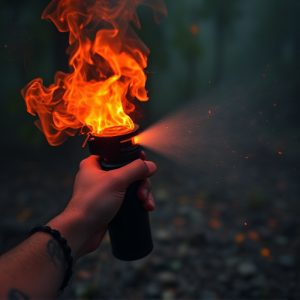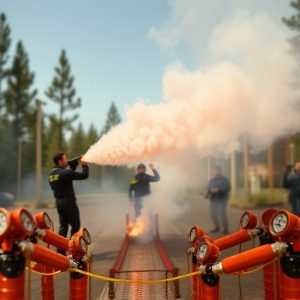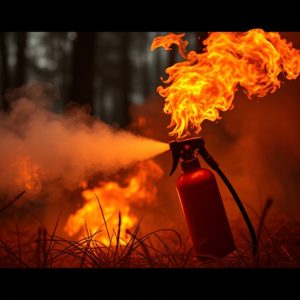Wildfire Pepper Spray: A Multifaceted Tool for Law Enforcement and Firefighting
Wildfire pepper spray is an essential non-lethal tool for both law enforcement and wildland firefig…….
Wildfire pepper spray is an essential non-lethal tool for both law enforcement and wildland firefighters, offering a high concentration of oleoresin capsaicinoid for effective incapacitation in various scenarios. Its use extends from managing crowds and active shooter situations to protecting critical infrastructure and landscapes against wildfires. The spray's potent formula induces immediate irritation upon contact, deterring both humans and wildlife, and can also aid in identifying arsonists. Its deployment not only incapacitates but also creates a visible cloud that can suppress wildfires by blocking oxygen for combustion. Importantly, the effects of the spray are swift yet reversible, ensuring humane treatment and minimal environmental impact. For law enforcement, proper training is key to deploying this tool effectively and safely, with a focus on overcoming environmental challenges and mitigating potential harm to bystanders. Agencies must integrate ongoing specialized training into their operations to maximize the benefits of wildfire pepper spray in enhancing public and officer safety during high-stress events and emergencies.
wildfire pepper spray has emerged as a critical tool in both law enforcement and wildland firefighting efforts. This article delves into the multifaceted applications of this potent deterrent, providing a thorough examination for law enforcement professionals who may utilize it. We explore its scientific foundation, effectiveness in controlling wildfires, strategic deployment by agencies, and the imperative of comprehensive training for preparedness. Understanding the nuances of wildfire pepper spray is crucial for both safeguarding personnel and managing natural disasters effectively.
Understanding Wildfire Pepper Spray: A Comprehensive Overview for Law Enforcement
Wildfire pepper spray serves as a critical tool for law enforcement agencies, offering an effective non-lethal means to incapacitate individuals who pose a threat. This advanced formula is engineered to deliver a powerful and rapidly acting irritant that can disorient and incapacitate subjects over a significant range. The spray’s oleoresin capsaicinoid (ORC) concentration sets it apart from conventional pepper sprays, providing a more potent and reliable response in high-stress situations. Its effectiveness is not diminished by wind or weather conditions, which can often compromise other less lethal munitions. Understanding the capabilities of this technology is essential for law enforcement personnel to employ it effectively and judiciously, ensuring both public safety and officer safety.
When integrating wildfire pepper spray into tactical operations, it’s crucial for officers to be well-versed in its application, including the proper techniques for deployment and the potential environmental impacts. The spray’s range, persistence, and effects should be carefully considered to avoid unintended consequences on bystanders or the surrounding environment. Training programs must be robust and inclusive of realistic scenarios to equip officers with the necessary skills to use this tool appropriately. By doing so, law enforcement can rely on wildfire pepper spray as a versatile and effective component of their less-lethal arsenal for crowd management, active shooter situations, and other high-risk encounters.
The Science Behind Wildfire Pepper Spray and Its Effectiveness in Wildland Firefighting
Wildfire pepper spray, a tactical tool employed by law enforcement in wildland firefighting, leverages the potent capsaicin found in chili peppers. This non-lethal agent is effective due to its active ingredient, which disrupts the nerve endings in mammals’ eyes and airways, causing an intense irritation that can deter both humans and wildlife. Upon deployment, the fine particles of pepper spray spread rapidly through the air, creating a visible cloud. When inhaled or coming into contact with the skin or eyes, the capsaicin triggers a strong sensory response—unbearable pain and coughing—that compels individuals to evacuate an area immediately. This response is crucial for both defensive purposes, such as protecting personnel and critical infrastructure from uncontrolled fires, and offensive measures against intentional fire-setting, or arson.
The science behind wildfire pepper spray’s effectiveness lies in its ability to create a temporary but powerful barrier between the advancing flames and the structures or landscapes it threatens. Its application can effectively slow down or halt the progress of a fire by preventing access to oxygen for the combustion process. Moreover, in surveillance operations, the unique properties of pepper spray can aid in tracking and deterring individuals who may be setting fires intentionally. The spray’s impact is both immediate and reversible once the exposure ceases, making it a humane yet highly effective tool in the arsenal of wildfire management and law enforcement tactics.
Strategic Deployment of Wildfire Pepper Spray by Law Enforcement Agencies
Law enforcement agencies have increasingly integrated Wildfire Pepper Spray into their arsenal for crowd management and tactical operations. This potent non-lethal tool is specifically designed to incapacitate individuals quickly, which can be pivotal in scenarios where de-escalation is the priority, and force may be necessary. The strategic deployment of Wildfire Pepper Spray allows officers to effectively manage large and unruly crowds during public events, protests, or civil unrest without resorting to more extreme measures. Its range and accuracy enable precise application, minimizing the exposure to bystanders and reducing the potential for collateral impact. The spray’s formula is engineered with a high concentration of oleoresin capsicoid, which induces an immediate inflammatory response upon contact with mucous membranes, thus temporarily impairing an individual’s ability to continue confrontational or dangerous behavior. This capability ensures that law enforcement can maintain public safety and order while upholding the principles of minimally invasive intervention.
The efficacy of Wildfire Pepper Spray is not confined to direct engagement with subjects; it also serves as a critical tool in preventative measures during wildfire events. In these scenarios, its use can deter individuals from entering high-risk areas, thereby protecting lives and property. The spray’s visibility as a deterrent factor is significant, as the potential for being sprayed acts as a compelling disincentive to ignore evacuation orders or trespass into hazardous zones. Furthermore, its deployment can facilitate the evacuation process by creating a clear perimeter that signals the boundaries of safe and unsafe areas, enhancing the overall coordination between law enforcement and emergency response teams during natural disaster responses. The strategic use of Wildfire Pepper Spray in both tactical situations and natural disaster management underscores its versatility and importance as a non-lethal tool for modern law enforcement agencies.
Training and Preparedness: Ensuring Law Enforcement Readiness for Effective Use of Wildfire Pepper Spray
Law enforcement agencies must prioritize the training and preparedness of their officers to effectively utilize Wildfire pepper spray, a critical tool for crowd management and control during wildfires or civil unrest. Comprehensive training programs are essential to equip officers with the knowledge and skills required to deploy this specialized pepper spray accurately and safely. These programs should cover the unique properties of Wildfire pepper spray, which includes a high concentration of oleoresin capsicum (OC) that can be delivered up to 20 feet, ensuring both safety at distance and effective incapacitation of subjects. Officers must understand the varying wind conditions, environmental factors, and potential collateral impacts when using the spray. Additionally, scenario-based training will help officers anticipate and respond appropriately to dynamic situations where Wildfire pepper spray might be employed, such as during evacuation orders or in defense against arson attacks.
Furthermore, ongoing practice and drills are necessary to maintain proficiency with Wildfire pepper spray. Realistic training exercises that simulate the chaotic conditions of wildfires or civil disturbances can help officers refine their technique and decision-making processes. Continuous training ensures that law enforcement personnel remain ready to deploy this tool effectively, minimizing risks to both the public and the officers themselves. It is through these rigorous training measures that agencies can guarantee their officers are prepared to use Wildfire pepper spray as part of a broader strategy to protect life, property, and the environment during critical events.


